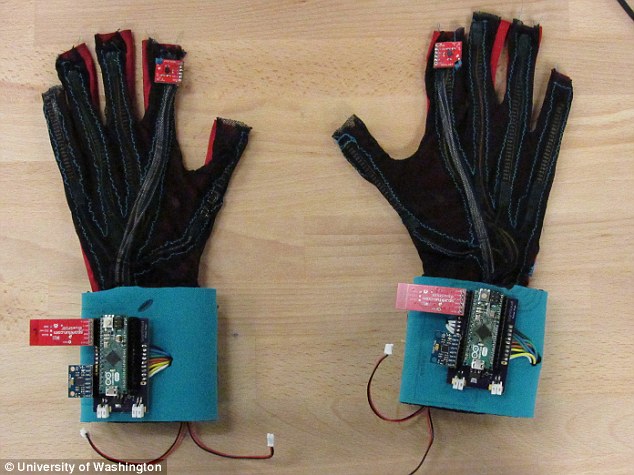'SignAloud' gloves translate sign language gestures into spoken English

For people living in a world without sound, sign language can make sure their points of view are heard.
But outside of the deaf and hard-of-hearing communities, this gesture-based language can lose its meaning.
'SignAloud' gloves translate sign language gestures into spoken English
Now a pair of entrepreneurial technology students in the US has designed a pair of gloves to break down the communication barriers, by translating hand gestures into speech.
Called 'SignAloud', the gloves use embedded sensors to monitor the position and movement of the user's hands.
Using this information, the gloves transmit the data via Bluetooth to a computer which analyses the movements and checks them against a library of gestures.
The system is based on machine learning algorithms that learn from a catalogue of signing examples.
In practice, if a hand gesture is a match then the appropriate sound is spoken by the computerised voice through a speaker.
In a demonstration video, inventors Thomas Pryor and Navid Azodi can be seen signing with the gloves, while a computerised voice translates the movements, saying: 'Hello, my name is Thomas and this is Navid. We are inventors in the Lemelson-MIT Student Prize competition.'
The two University of Washington students recently picked up the $10,000 (£6,920) top prize for their innovative design, which currently translates from American Sign Language to English.
'Many of the sign language translation devices already out there are not practical for everyday use. Some use video input, while others have sensors that cover the user's entire arm or body,' explained Pryor.
'Our gloves are lightweight, compact and worn on the hands, but ergonomic enough to use as an everyday accessory, similar to hearing aids or contact lenses.'
According to the team, the primary audience for the device is the deaf and hard-of-hearing community and those interested in learning and working with American Sign Language.
However, the designers believe the gloves could find uses in other fields, such as monitoring stroke patients during their rehabilitation, or for gesture control and improved dexterity with virtual reality technology.
Other groups have been working on similar technology.
In 2012, researchers in Ukraine were awarded first prize in the Microsoft Imagine Cup for a similar gesture to speech system.
Called EnableTalk, the concept design used sensors in gloves and a mobile device to translate the hand gestures.
More recently a collaborative group from New Zealand and Malaysia showed progress on a sign to text program which translated gestures from Malaysian Sign Language to multiple languages.
In 2014, the team behind the Automatic Sign Language Translator (ASLT) said its early stage technology could be economical enough for mass production and for use on mobile devices.
The ultimate aim in this field is to use technology to break down barriers to communication which may hold back deaf and hard-of-hearing people in their daily lives.
Courtesy: Daily Mail UK






